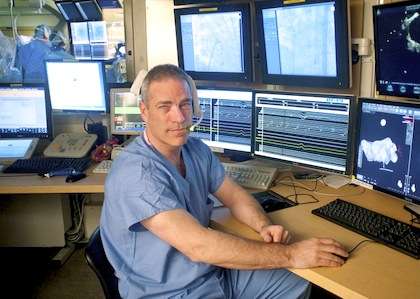Accurate computational model of the electrical behavior of the human heart

Physician scientists can find inspiration – and solutions – in every corner of an academic medical center: the clinic, the research arena, or while teaching. That's how Peter Spector, M.D., a University of Vermont professor of medicine and director of electrophysiology at Fletcher Allen Health Care, came to co-develop – with Professor of Medicine and engineer Jason Bates, Ph.D. – a three-dimensional computational model of a human heart called Visible EP.
The software technology that Spector and Bates built is as remarkable as their collaboration. Spector came to the table with the vision of the final product and a deep understanding of electrophysiology and how the heart works, but was unfamiliar with the programming process. Bates possessed programming skills and expertise in computational models. Together, they produced a technology that very accurately models the electrical behavior of the human heart, to the smallest level of detail.
Bates and Spector created Visible EP (which stands for "electrophysiology") as a means to gain a better understanding of how to cure the most common abnormal heart rhythm – atrial fibrillation (AF) – which afflicts more than five million people in the U.S. alone. To date, says Spector, treatment has been less than adequate.
The result of their teamwork is a program that mimics the behavior of the heart from every aspect, as well as features the ability to provide unpredictable responses – a phenomenon called emergent behavior. While the parts of the heart and the rules of interaction have been programmed into the system, the computational heart model's reaction is entirely emergent, says Spector.
"We've made, essentially, a living, breathing, interactive human heart," he says. "It will sit there and beat in what would be the equivalent of a normal rhythm; you can induce every sort of abnormal heart rhythm that you can imagine that a patient could have, and it's all happening on a computer screen."
Visible EP's emergent behavior feature makes it an attractive tool for medical education, as well as research applications. Because it can't be readily seen, electrophysiology has been regarded as a particularly difficult specialty to teach; the field was waiting for just such a teaching tool as Visible EP.
Spector and Bates were recognized with an award for licensing Visible EP at the 2013 Vermont Invention to Venture conference, an annual day-long event co-organized by UVM's Office of Technology Commercialization. In summer 2013, Spector officially set up shop as founder and director of his spinoff, Visible Electrophysiology, LLC, a medical simulation company whose staff includes a chief technology officer and educational product manager at Visible EP.
Spector uses the Visible EP technology in his arrhythmia research lab, where his team consists of three biomedical engineering doctoral students and a postdoctoral MD research fellow. Using this computer model, combined with studies of the real human heart, the group has proposed a new approach to analyzing an individual patient's electrical activity and to using this information to guide a new type of ablation. In addition, the team has developed a new catheter, signal processing algorithms and a mapping approach for treatment of AF. This work has been sponsored by a generous grant from the Evslin Foundation and has led to the submission of eight patent applications through the University's Office of Technology Commercialization.

















